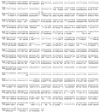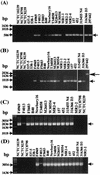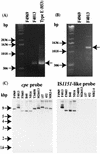Organization of the plasmid cpe Locus in Clostridium perfringens type A isolates
- PMID: 12117935
- PMCID: PMC128129
- DOI: 10.1128/IAI.70.8.4261-4272.2002
Organization of the plasmid cpe Locus in Clostridium perfringens type A isolates
Erratum in
- Infect Immun. 2003 Mar;71(3):1611
Abstract
Clostridium perfringens type A isolates causing food poisoning have a chromosomal enterotoxin gene (cpe), while C. perfringens type A isolates responsible for non-food-borne human gastrointestinal diseases carry a plasmid cpe gene. In the present study, the plasmid cpe locus of the type A non-food-borne-disease isolate F4969 was sequenced to design primers and probes for comparative PCR and Southern blot studies of the cpe locus in other type A isolates. Those analyses determined that the region upstream of the plasmid cpe gene is highly conserved among type A isolates carrying a cpe plasmid. The organization of the type A plasmid cpe locus was also found to be unique, as it contains IS1469 sequences located similarly to those in the chromosomal cpe locus but lacks the IS1470 sequences found upstream of IS1469 in the chromosomal cpe locus. Instead of those upstream IS1470 sequences, a partial open reading frame potentially encoding cytosine methylase (dcm) was identified upstream of IS1469 in the plasmid cpe locus of all type A isolates tested. Similar dcm sequences were also detected in several cpe-negative C. perfringens isolates carrying plasmids but not in type A isolates carrying a chromosomal cpe gene. Contrary to previous reports, sequences homologous to IS1470, rather than IS1151, were found downstream of the plasmid cpe gene in most type A isolates tested. Those IS1470-like sequences reside in about the same position but are oppositely oriented and defective relative to the IS1470 sequences found downstream of the chromosomal cpe gene. Collectively, these and previous results suggest that the cpe plasmid of many type A isolates originated from integration of a cpe-containing genetic element near the dcm sequences of a C. perfringens plasmid. The similarity of the plasmid cpe locus in many type A isolates is consistent with horizontal transfer of a common cpe plasmid among C. perfringens type A strains.
Figures








Similar articles
-
Multiplex PCR genotyping assay that distinguishes between isolates of Clostridium perfringens type A carrying a chromosomal enterotoxin gene (cpe) locus, a plasmid cpe locus with an IS1470-like sequence, or a plasmid cpe locus with an IS1151 sequence.J Clin Microbiol. 2004 Apr;42(4):1552-8. doi: 10.1128/JCM.42.4.1552-1558.2004. J Clin Microbiol. 2004. PMID: 15071003 Free PMC article.
-
Complete sequencing and diversity analysis of the enterotoxin-encoding plasmids in Clostridium perfringens type A non-food-borne human gastrointestinal disease isolates.J Bacteriol. 2006 Feb;188(4):1585-98. doi: 10.1128/JB.188.4.1585-1598.2006. J Bacteriol. 2006. PMID: 16452442 Free PMC article.
-
Association of beta2 toxin production with Clostridium perfringens type A human gastrointestinal disease isolates carrying a plasmid enterotoxin gene.Mol Microbiol. 2005 May;56(3):747-62. doi: 10.1111/j.1365-2958.2005.04573.x. Mol Microbiol. 2005. PMID: 15819629
-
Enterotoxigenic Clostridium perfringens: detection and identification.Microbes Environ. 2012;27(4):343-9. doi: 10.1264/jsme2.me12002. Epub 2012 Apr 14. Microbes Environ. 2012. PMID: 22504431 Free PMC article. Review.
-
Clostridium perfringens and foodborne infections.Int J Food Microbiol. 2002 Apr 5;74(3):195-202. doi: 10.1016/s0168-1605(01)00680-8. Int J Food Microbiol. 2002. PMID: 11981970 Review.
Cited by
-
Genotypic and phenotypic characterization of Clostridium perfringens isolates from Darmbrand cases in post-World War II Germany.Infect Immun. 2012 Dec;80(12):4354-63. doi: 10.1128/IAI.00818-12. Epub 2012 Oct 1. Infect Immun. 2012. PMID: 23027533 Free PMC article.
-
Identification of novel Clostridium perfringens type E strains that carry an iota toxin plasmid with a functional enterotoxin gene.PLoS One. 2011;6(5):e20376. doi: 10.1371/journal.pone.0020376. Epub 2011 May 31. PLoS One. 2011. PMID: 21655254 Free PMC article.
-
Humans as reservoir for enterotoxin gene--carrying Clostridium perfringens type A.Emerg Infect Dis. 2006 Nov;12(11):1724-9. doi: 10.3201/eid1211.060478. Emerg Infect Dis. 2006. PMID: 17283623 Free PMC article.
-
Prevalence of enterotoxigenic Clostridium perfringens Isolates in Pittsburgh (Pennsylvania) area soils and home kitchens.Appl Environ Microbiol. 2007 Nov;73(22):7218-24. doi: 10.1128/AEM.01075-07. Epub 2007 Sep 28. Appl Environ Microbiol. 2007. PMID: 17905877 Free PMC article.
-
Clostridium perfringens Enterotoxin: Action, Genetics, and Translational Applications.Toxins (Basel). 2016 Mar 16;8(3):73. doi: 10.3390/toxins8030073. Toxins (Basel). 2016. PMID: 26999202 Free PMC article. Review.
References
-
- Brynestad, S., and P. E. Granum. 1999. Evidence that Tn5565, which includes the enterotoxin gene in Clostridium perfringens, can have a circular form which may be a transposition intermediate. FEMS Microbiol. Lett. 170:281-286. - PubMed
-
- Brynestad, S., L. A. Iwanejko, G. S. A. B. Stewart, and P. E. Granum. 1994. A complex array of Hpr consensus DNA recognition sequences proximal to the enterotoxin gene in Clostridium perfringens type A. Microbiology 140:97-104. - PubMed
-
- Brynestad, S., B. Synstad, and P. E. Granum. 1997. The Clostridium perfringens enterotoxin gene is on a transposable element in type A human food poisoning strains. Microbiology 143:2109-2115. - PubMed
Publication types
MeSH terms
Substances
Associated data
- Actions
- Actions
- Actions
- Actions
- Actions
Grants and funding
LinkOut - more resources
Full Text Sources
Molecular Biology Databases
Research Materials
Miscellaneous

